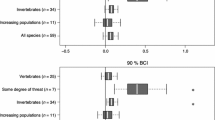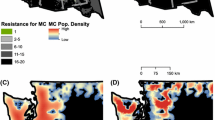Abstract
This study examines the predictive accuracy of the population viability analysis package, ALEX (Analysis of the Likelihood of EXtinction). ALEX was used to predict the probability of patch occupancy for two species of small native Australian mammals (Antechinus agilis and Rattus fuscipes) among 13 patches of suitable habitat in a matrix of plantation pines (Pinus radiata). The study was retrospective, running each simulation from 1900 until 1997, and the model parameterised without knowledge of the 1997 observed field data of patch occupancy. Predictions were made over eight scenarios for each species, allowing for variation in the amount of dispersal between patches, level of environmental stochasticity, and size of habitat patches. Predicted occupancies were compared to the 1997 field data of patch occupancy using logistic regression, testing H random, that there was no relationship between observed and predicted occupancy, and H perfect, that there was a perfect, 1:1 relationship between observed and predicted occupancies. Rejection of H random and failure to reject H perfect was taken as a good match between observed and predicted occupancies. Such a match was found for one scenario with R. fuscipes, and no scenarios with A. agilis. In general, patch occupancy was underestimated, with field surveys finding that 9 of the 13 patches were occupied by R. fuscipes and 10 by A. agilis. Nonetheless, PVA predictions were in the ‘right direction’, whereby patches predicted to have a high probability of occupancy were generally occupied, and vice versa. A post hoc search over additional scenarios found few scenarios with a better match than the original eight. The results of this study support the notion that PVA is best thought of as a relative, rather than absolute predictor of the consequences of management actions in threatened populations.
Similar content being viewed by others
References
Barnett J.L., How R.A. and Humphreys W.F. 1977. Small mammal populations in pine and native forests in north-eastern New South Wales. Australian Wildlife Research 4: 233-240.
Beissinger S.R. and Westphal M.I. 1998. On the use of demographic models of population viability in endangered species management. Journal of Wildlife Management 62: 821-841.
Bennett A.F. 1987. Conservation of mammals within a fragmented forest environment: the contributions of insular biogeography and autecology. In: Saunders D.A., Arnold G.W., Burbidge A.A. and Hopkins A.J.M. (eds), Nature Conservation: the Role of Remnants of Native Vegetation. Surrey Beatty and Sons, Sydney, Australia, pp. 41-52.
Boyce M.S. 1992. Population viability analysis. Annual Review of Ecology and Systematics 23: 481-506.
Brook B.W., O'Grady J.J., Chapman A.P., Burgman M.A., Akcakaya H.R. and Frankham R. 1982. Predictive accuracy of population viability analysis in conservation biology. Nature 404: 385-387.
Cockburn A. 1994. Adaptive sex allocation by brood reduction in antechinuses. Behavioural Ecology and Sociobiology 35: 53-62.
Cockburn A., Lee A.K. and Martin R.W. 1983. Macrogeographic variation in litter size in Antechinus (Marsupialia: Dasyuridae). Evolution 37: 86-95.
Cockburn A., Scott M.P. and Scotts D.J. 1985. Inbreeding avoidance and male-biased dispersal in Antechinus spp. (Marsupialia: Dasyuridae). Animal Behaviour 33: 908-915.
Day J.R. and Possingham H.P. 1995. A stochastic metapopulation model with variability in patch size and position. Theoretical Population Biology 48: 333-360.
Dickman C.R. 1980. Ecological studies of Antechinus stuartii and Antechinus flavipes (Marsupialia: Dasyuridae) in open-forest and woodland habitats. Australian Zoologist 20: 433-446.
Dickman C.R. 1989. Demographic responses of Antechinus stuartii (Marsupialia) to supplementary food. Australian Journal of Ecology 14: 387-398.
Dickman C.R., King D.H., Adams M. and Baverstock P.R. 1988. Electrophoretic identification of a new species of Antechinus (Marsupialia: Dasyuridae) in south-eastern Australia. Australian Journal of Zoology 36: 455-463.
Dickman C.R., Parnaby H.E., Crowther M.S. and King D.H. 1998. Antechinus agilis (Marsupialia: Dasyuridae), a new species from the A. stuartii complex in south-eastern Australia. Australian Journal of Zoology 46: 1-26.
Dunstan C.E. and Fox B.J. 1996. The effects of fragmentation and disturbance of rainforest on ground-dwelling small mammals on the Robertson Plateau, New South Wales, Australia. Journal of Biogeography 23: 187-201.
Fielding A.H. and Bell J.F. 1997. A review of methods for the assessment of prediction errors in conservation presence / absence models. Environmental Conservation 24: 38-49.
Frankham R. 1998. Inbreeding and extinction: island populations. Conservation Biology 12: 665-675.
Gaona P., Ferreras P. and Delibes M. 1998. Dynamics and viability of a metapopulation of the endangered Iberian lynx (Lynx pardinus). Ecological Monographs 68: 349-370.
Goldingay R. and Possingham H. 1995. Area requirements for viable populations of the Australian gliding marsupial Petaurus australis. Biological Conservation 73: 161-167.
Greenwood P.J. 1980. Mating systems, philopatry and dispersal in birds and mammals. Animal Behaviour 28: 1140-1162.
Hamilton S. and Moller H. 1995. Can PVA models using computer packages offer useful conservation advice? Sooty shearwaters Puffinus griseus in New Zealand as a case study. Biological Conservation 73: 107-117.
Hedrick P.W. and Kalinowski S.T. 2000. Inbreeding depression in conservation biology. Annual Review of Ecology and Systematics 31: 139-162.
Horner B.E. and Taylor J.M. 1965. Systematic relationships among Rattus in southern Australia: evidence from cross-breeding experiments. Wildlife Research 10: 101-109.
Lacy R.C. 1993. VORTEX: a computer simulation model for population viability analysis. Wildlife Research 20: 45-65.
Lindenmayer D.B., Burgman M.A., Akcakaya H.R., Lacy R.C. and Possingham H.P. 1995. A review of the generic computer programs ALEX, RAMAS/ space and VORTEX for modelling the viability of wildlife metapopulations. Ecological Modelling 82: 161-174.
Lindenmayer D.B. and Lacy R.C. 2002. Small mammals, habitat patches and PVA models: a field test of model predictive ability. Biological Conservation 103: 247-265.
Lindenmayer D.B. and Possingham H.P. 1995. The conservation of arboreal marsupials in the montane ash forests of the central highlands of Victoria, south-eastern Australia-VII. Modelling the persistence of leadbeater's possum in response to modified timber harvesting practices. Biological Conservation 73: 239-257.
Lindenmayer D.B., Lacy R.C. and Pope M.L. 2000. Testing a simulation model for population viability analysis. Ecological Applications 10: 580-597.
Lindenmayer D.B., McCarthy M.A., Possingham H.P. and Legge S. 2001. A simple landscape-scale test of a spatially explicit population model: patch occupancy in fragmented south-eastern Australian forests. Oikos 92: 445-458.
Manel S., Williams H.C. and Ormerod S.J. 2001. Evaluating presence-absence models in ecology: the need to account for prevalence. Journal of Applied Ecology 38: 921-931.
Marmontel M., Humphrey S.R. and O'Shea T.J. 1997. Population viability analysis of the Florida manatee (Trichechus manatus latirostris), 1976-1991. Conservation Biology 11: 467-481.
McCarthy M.A., Lindenmayer D.B. and Possingham H.P. 2000. Testing spatial PVA models of Australian treecreepers (Aves: Climacteridae) in fragmented forest. Ecological Applications 10: 1722-1731.
McCarthy M.A., Lindenmayer D.B. and Possingham H.P. 2001a. Assessing spatial PVA models of arboreal marsupials using significance tests and Bayesian statistics. Biological Conservation 98: 191-200.
McCarthy M.A., Possingham H.P., Day J.R. and Tyre A.J. 2001b. Testing the accuracy of population viability analysis. Conservation Biology 15: 1030-1038.
Pearce J. and Ferrier S. 2000. Evaluating the predictive performance of habitat models developed using logistic regression. Ecological Modelling 133: 225-245.
Possingham H.P. and Davies I. 1995. ALEX: a model for the viability analysis of spatially structured populations. Biological Conservation 73: 143-150.
Possingham H.P., Lindenmayer D.B., Norton T.W. and Davies I. 1994. Metapopulation viability analysis of the greater glider Petauroides volans in a wood production area. Biological Conservation 70: 227-236.
Press A.J. 1987. Comparison of the demography of populations of Rattus fuscipes living in cool temperate rainforests and dry sclerophyll forests. Australian Wildlife Research 14: 45-63.
Robinson A.C. 1987. The ecology of the bush rat, Rattus fuscipes (Rodentia: Muridae), in Sherbrooke Forest, Victoria. Australian Mammalogy 11: 35-49.
Stewart A.P. 1979. Trapping success in relation to trap placement with three species of small mammals, Rattus fuscipes, Antechinus swainsonii and A. stuartii. Australian Wildlife Research 6: 165-172.
Strahan R. 1995. The Mammals of Australia. 2nd edn. New Holland Publishers, Melbourne, Australia.
Suckling G.C. and Heislers A. 1978. Populations of four small mammals in radiata pine plantations and eucalypt forest of north-eastern Victoria. Australian Wildlife Research 5: 305-315.
Sutherland D.R. and Predavec M. 1999. The effects of moonlight on microhabitat use by Antechinus agilis (Marsupialia: Dasyuridae). Australian Journal of Zoology 47: 1-17.
Taylor J.M. 1961. Reproductive biology of the Australian bush rat Rattus assimilis. University of California Publications in Zoology 60: 1-66.
Warneke R.M. 1971. Field study of the bush rat (Rattus fuscipes). Wildlife Contributions, Victoria, No.14.
Wilson B.A., Bourne A.R. and Jessop R.E. 1986. Ecology of small mammals in coastal heathland at Anglesea, Victoria. Australian Wildlife Research 13: 397-406.
Wood D.H. 1970. An ecological study of Antechinus stuartii (Marsupialia) in a south-east Queensland rain forest. Australian Journal of Zoology 18: 185-207.
Wood D.H. 1971. The ecology of Rattus fuscipes and Melomys cervinipes (Rodentia: Muridae) in a south-east Queensland rain forest. Australian Journal of Zoology 19: 371-392.
Author information
Authors and Affiliations
Corresponding author
Rights and permissions
About this article
Cite this article
Ball, S.J., Lindenmayer, D.B. & Possingham, H.P. The predictive accuracy of population viability analysis: a test using data from two small mammal species in a fragmented landscape. Biodiversity and Conservation 12, 2393–2413 (2003). https://doi.org/10.1023/A:1025821506931
Issue Date:
DOI: https://doi.org/10.1023/A:1025821506931




